Top Features to Look for in a High-Quality Membrane Switch
Top Features to Look for in a High-Quality Membrane Switch
Blog Article
Comprehending Membrane Changes: The Trick to Reliable and durable Controls

What Are Membrane Layer Buttons?
Membrane buttons are a sophisticated solution in the world of interface technology, combining performance and layout seamlessly. These gadgets offer as an interface in between individuals and electronic systems, integrating several components right into a portable style. Normally built from versatile, thin layers of products, membrane buttons are developed to react to touch, making it possible for customers to connect with machinery and electronic devices successfully.
The main elements of a membrane button include a published circuit layer, visuals overlay, and a spacer layer that prevents unintentional activation. The visuals overlay can be personalized to reflect brand name identity or customer choices, improving looks while guaranteeing functionality. Membrane layer buttons are commonly made use of in different applications, including medical devices, consumer electronics, and commercial devices, owing to their resilience and resistance to ecological variables such as moisture and dust.
One of the essential benefits of membrane layer buttons is their ability to withstand wear and tear, making them optimal for high-traffic atmospheres. Furthermore, they are lightweight and require very little space, permitting cutting-edge layouts in item growth. Generally, membrane switches represent a reliable and practical option for contemporary digital user interfaces, weding technology with user-centric design principles.
Just How Membrane Switches Over Job
The operation of membrane switches joints on a simple yet effective system that converts customer input right into electronic signals. When a user presses the button, the top layer deforms, allowing a conductive element in the circuit layer to make call with a matching conductive pad on the underside of the graphic overlay.
The design of membrane switches can differ, yet they often integrate domes or responsive elements to offer responses to the individual, enhancing the overall experience - membrane switch. The products made use of in membrane buttons, such as polyester or polycarbonate, add to their longevity and resistance to environmental aspects, consisting of dampness and dirt. Furthermore, the printed circuits are usually encapsulated, which secures them from deterioration in time.
Advantages of Membrane Switches

Additionally, membrane switches are understood for their durability. Constructed from durable products, they are immune to dirt, moisture, and physical wear, which dramatically prolongs their lifespan contrasted to conventional mechanical switches. This resilience makes them specifically appropriate for high-traffic settings and applications needing long life.
Another significant advantage is the simplicity of cleansing and maintenance. The smooth surface area of membrane layer changes minimizes dirt accumulation and get redirected here is typically unsusceptible spills, making them optimal for settings that require frequent sanitization.
Moreover, membrane layer switches offer a streamlined profile, causing a thinner design that can be integrated into numerous tools without adding mass. This function not just improves the visual appeal yet also contributes to a more ergonomic product style.
Applications of Membrane Buttons
User-friendly and versatile, membrane buttons locate applications throughout a variety of industries, including medical tools, customer electronics, and commercial equipment. In the clinical area, these switches are important to devices such as analysis equipment, patient tracking systems, and infusion pumps, where reliability and convenience of cleansing are vital. Their capability to withstand extreme settings and preserve capability makes them suitable for such applications.

In customer electronics, membrane layer switches are made use of in products like microwaves, washing makers, and remotes - membrane switch. Their streamlined design enables user-friendly customer interfaces, boosting the total customer experience while giving sturdiness and resistance to tear and use
Commercial devices likewise takes advantage of membrane layer buttons, specifically in control panels for machinery and automation systems. These switches provide defense against dirt and moisture, making certain constant performance in tough atmospheres. Their customizable features permit manufacturers to tailor them to details operational demands, enhancing efficiency and functionality.
Picking the Right Membrane Layer Switch
When choosing a membrane layer switch, it is vital to consider numerous variables learn this here now that influence efficiency and suitability for details applications. The main considerations include environmental conditions, tactile feedback, longevity, and layout specs.
First, examine the operating setting; buttons exposed to dampness, chemicals, or extreme temperatures need particular materials to make certain durability and capability. Next off, assess the requirement for tactile comments. Depending upon user interaction, some applications may take advantage of a responsive reaction to confirm activation, while others might prefer a non-tactile layout for aesthetic factors.
Toughness is another important element; membrane buttons ought to be created to hold up against constant use, effects, and abrasion. Guarantee the selected button can withstand the expected lifecycle, especially in high-usage circumstances.

Conclusion
In conclusion, membrane layer switches offer as essential elements in the style of long lasting and reputable control systems throughout different markets. The adaptability of membrane switches over permits for customized solutions that meet certain functional needs, reinforcing their importance in modern-day innovation.
Membrane switches represent an important aspect of modern interface layout, blending performance with resilience in various applications.Membrane layer switches are a sophisticated option in the world of user interface innovation, integrating functionality and design flawlessly. Commonly created from versatile, thin important link layers of products, membrane layer switches are created to respond to touch, allowing customers to communicate with machinery and digital gadgets properly.
The design of membrane switches can vary, but they often incorporate domes or tactile aspects to supply feedback to the individual, boosting the total experience.In conclusion, membrane switches over offer as important parts in the design of reliable and durable control systems throughout various sectors.
Report this page